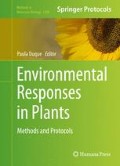Abstract
Plants produce new organs from a population of pluripotent cells which are located in specific tissues called meristems. One of these meristems, the shoot apical meristem (SAM), gives rise to leaves during the vegetative phase and flowers during the reproductive phase. The transition from vegetative SAM to an inflorescence meristem (IM) is a dramatic developmental switch, which has been particularly well studied in the model species Arabidopsis thaliana. This developmental switch is controlled by multiple environmental signals such as day length (or photoperiod), and it is accompanied by changes in expression of hundreds of genes. A major interest in plant biology is to identify and characterize those genes which are regulated in the stem cells of the SAM in response to the photoperiodic signals. In this sense, techniques such as RNA in situ hybridization (RNA ISH) have been very successfully employed to detect the temporal and spatial expression patterns of genes in the SAM. This method can be specifically optimized for photoperiodic-flowering studies. In this chapter, we describe improved methods to generate plant material and histological samples to be combined with RNA ISH in flowering-related studies.
Access this chapter
Tax calculation will be finalised at checkout
Purchases are for personal use only
References
Koornneef M, Hanhart CJ, van der Veen JH (1991) A genetic and physiological analysis of late flowering mutants in Arabidopsis thaliana. Mol Gen Genet 229(1):57–66
Andres F, Coupland G (2012) The genetic basis of flowering responses to seasonal cues. Nat Rev Genet 13(9):627–639
Blazquez MA, Soowal LN, Lee I, Weigel D (1997) LEAFY expression and flower initiation in Arabidopsis. Development 124(19):3835–3844
Mantegazza O, Gregis V, Chiara M, Selva C, Leo G, Horner DS, Kater MM (2014) Gene coexpression patterns during early development of the native Arabidopsis reproductive meristem: novel candidate developmental regulators and patterns of functional redundancy. Plant J 79(5):861–877
Schmid M, Uhlenhaut NH, Godard F, Demar M, Bressan R, Weigel D, Lohmann JU (2003) Dissection of floral induction pathways using global expression analysis. Development 130(24):6001–6012
Torti S, Fornara F, Vincent C, Andres F, Nordstrom K, Gobel U, Knoll D, Schoof H, Coupland G (2012) Analysis of the Arabidopsis shoot meristem transcriptome during floral transition identifies distinct regulatory patterns and a leucine-rich repeat protein that promotes flowering. Plant Cell 24(2):444–462
Jackson D (ed) (1992) In sit hybridization in plants. Molecular plant pathology. A practical approach. Oxford University Press, Oxford
Carles CC, Ha CM, Jun JH, Fiume E, Fletcher JC (2010) Analyzing shoot apical meristem development. Plant Dev Biol 655:105–129
Gall JG, Pardue ML (1969) Formation and detection of RNA-DNA hybrid molecules in cytological preparations. Proc Natl Acad Sci U S A 63(2):378–383
Hejatko J, Blilou I, Brewer PB, Friml J, Scheres B, Benkova E (2006) In situ hybridization technique for mRNA detection in whole mount Arabidopsis samples. Nat Protoc 1(4):1939–1946
Drea S, Derbyshire P, Koumproglou R, Dolan L, Doonan JH, Shaw P (2009) In situ analysis of gene expression in plants. Methods Mol Biol 513:229–242
Turck F, Fornara F, Coupland G (2008) Regulation and identity of florigen: FLOWERING LOCUS T moves center stage. Annu Rev Plant Biol 59:573–594
Acknowledgements
The work in George Coupland’s lab is funded by the European Research Council, the Cluster of Excellence in Plant Sciences (CEPLAS), and a core grant from the Max Planck Society.
Author information
Authors and Affiliations
Corresponding author
Editor information
Editors and Affiliations
Rights and permissions
Copyright information
© 2016 Springer Science+Business Media New York
About this protocol
Cite this protocol
Andrés, F., Torti, S., Vincent, C., Coupland, G. (2016). Sample Preparation of Arabidopsis thaliana Shoot Apices for Expression Studies of Photoperiod-Induced Genes. In: Duque, P. (eds) Environmental Responses in Plants. Methods in Molecular Biology, vol 1398. Humana Press, New York, NY. https://doi.org/10.1007/978-1-4939-3356-3_8
Download citation
DOI: https://doi.org/10.1007/978-1-4939-3356-3_8
Published:
Publisher Name: Humana Press, New York, NY
Print ISBN: 978-1-4939-3354-9
Online ISBN: 978-1-4939-3356-3
eBook Packages: Springer Protocols

